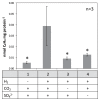Nitrogen Fixation in Thermophilic Chemosynthetic Microbial Communities Depending on Hydrogen, Sulfate, and Carbon Dioxide
- PMID: 29367473
- PMCID: PMC5877335
- DOI: 10.1264/jsme2.ME17134
Nitrogen Fixation in Thermophilic Chemosynthetic Microbial Communities Depending on Hydrogen, Sulfate, and Carbon Dioxide
Abstract
The activity of nitrogen fixation measured by acetylene reduction was examined in chemosynthetic microbial mats at 72-75°C in slightly-alkaline sulfidic hot springs in Nakabusa, Japan. Nitrogenase activity markedly varied from sampling to sampling. Nitrogenase activity did not correlate with methane production, but was detected in samples showing methane production levels less than the maximum amount, indicating a possible redox dependency of nitrogenase activity. Nitrogenase activity was not affected by 2-bromo-ethane sulfonate, an inhibitor of methanogenesis. However, it was inhibited by the addition of molybdate, an inhibitor of sulfate reduction and sulfur disproportionation, suggesting the involvement of sulfate-reducing or sulfur-disproportionating organisms. Nitrogenase activity was affected by different O2 concentrations in the gas phase, again supporting the hypothesis of a redox potential dependency, and was decreased by the dispersion of mats with a homogenizer. The loss of activity that occurred from dispersion was partially recovered by the addition of H2, sulfate, and carbon dioxide. These results suggested that the observed activity of nitrogen fixation was related to chemoautotrophic sulfate reducers, and fixation may be active in a limited range of ambient redox potential. Since thermophilic chemosynthetic communities may resemble ancient microbial communities before the appearance of photosynthesis, the present results may be useful when considering the ancient nitrogen cycle on earth.
Keywords: chemoautotrophic bacteria; microbial mats; nitrogen fixation; sulfate reduction; thermophilic bacteria.
Figures






Similar articles
-
Phylogenetic Diversity of Nitrogenase Reductase Genes and Possible Nitrogen-Fixing Bacteria in Thermophilic Chemosynthetic Microbial Communities in Nakabusa Hot Springs.Microbes Environ. 2018 Dec 28;33(4):357-365. doi: 10.1264/jsme2.ME18030. Epub 2018 Nov 7. Microbes Environ. 2018. PMID: 30404970 Free PMC article.
-
Nitrogenase Activity in Thermophilic Chemolithoautotrophic Bacteria in the Phylum Aquificae Isolated under Nitrogen-Fixing Conditions from Nakabusa Hot Springs.Microbes Environ. 2018 Dec 28;33(4):394-401. doi: 10.1264/jsme2.ME18041. Epub 2018 Nov 23. Microbes Environ. 2018. PMID: 30473565 Free PMC article.
-
Nitrogen fixation in distinct microbial niches within a chemoautotrophy-driven cave ecosystem.ISME J. 2013 Dec;7(12):2411-23. doi: 10.1038/ismej.2013.126. Epub 2013 Aug 8. ISME J. 2013. PMID: 23924780 Free PMC article.
-
Coordinated regulation of nitrogen fixation and molybdate transport by molybdenum.Mol Microbiol. 2019 Jan;111(1):17-30. doi: 10.1111/mmi.14152. Epub 2018 Nov 14. Mol Microbiol. 2019. PMID: 30325563 Review.
-
'That which does not kill us only makes us stronger': the role of carbon monoxide in thermophilic microbial consortia.Environ Microbiol. 2009 May;11(5):1027-37. doi: 10.1111/j.1462-2920.2009.01865.x. Epub 2009 Feb 23. Environ Microbiol. 2009. PMID: 19239487 Review.
Cited by
-
Nitrogen-fixing Ability and Nitrogen Fixation-related Genes of Thermophilic Fermentative Bacteria in the Genus Caldicellulosiruptor.Microbes Environ. 2021;36(2):ME21018. doi: 10.1264/jsme2.ME21018. Microbes Environ. 2021. PMID: 34108360 Free PMC article.
-
In-Situ Metatranscriptomic Analyses Reveal the Metabolic Flexibility of the Thermophilic Anoxygenic Photosynthetic Bacterium Chloroflexus aggregans in a Hot Spring Cyanobacteria-Dominated Microbial Mat.Microorganisms. 2021 Mar 21;9(3):652. doi: 10.3390/microorganisms9030652. Microorganisms. 2021. PMID: 33801086 Free PMC article.
-
A Novel Archaeal Lineage in Boiling Hot Springs around Oyasukyo Gorge (Akita, Japan).Microbes Environ. 2021;36(4):ME21048. doi: 10.1264/jsme2.ME21048. Microbes Environ. 2021. PMID: 34819404 Free PMC article.
-
Whither the genus Caldicellulosiruptor and the order Thermoanaerobacterales: phylogeny, taxonomy, ecology, and phenotype.Front Microbiol. 2023 Aug 3;14:1212538. doi: 10.3389/fmicb.2023.1212538. eCollection 2023. Front Microbiol. 2023. PMID: 37601363 Free PMC article.
-
Microorganisms and Their Metabolic Capabilities in the Context of the Biogeochemical Nitrogen Cycle at Extreme Environments.Int J Mol Sci. 2020 Jun 13;21(12):4228. doi: 10.3390/ijms21124228. Int J Mol Sci. 2020. PMID: 32545812 Free PMC article. Review.
References
-
- Alain K., Postec A., Grinsard E., Lesongeur F., Prieur D., Godfroy A. Thermodesulfatator atlanticus sp. nov., a thermophilic, chemolithoautotrophic, sulfate-reducing bacterium isolated from a Mid-Atlantic Ridge hydrothermal vent. Int J Syst Evol Microbiol. 2010;60:33–38. - PubMed
-
- Amend J.P., Shock E.L. Energetics of overall metabolic reactions of thermophilic and hyperthermophilic Archaea and Bacteria. FEMS Microbiol Rev. 2001;25:175–243. - PubMed
-
- Baena S., Perdomo N., Carvajal C., Díaz C., Patel B.K.C. Desulfosoma caldarium gen. nov., sp. nov., a thermophilic sulfatereducing bacterium from a terrestrial hot spring. Int J Syst Evol Microbiol. 2011;61:732–736. - PubMed
-
- Bebout B.M., Paerl H.W., Bauer J.E., Canfield D.E., Des Marais D.J. Nitrogen cycling in microbial mat communities: the quantitative importance of N-fixation and other sources of N for primary productivity. In: Stal LJ, Caumette P, editors. Microbial Mats. Springer-Verlag; Berlin: 1994. pp. 265–272.
MeSH terms
Substances
LinkOut - more resources
Full Text Sources
Other Literature Sources

